Ancient Origins: Pre-Buddhist Roots to Buddhist Integration
The history of Tibetan incense is deeply rooted in the spiritual and cultural practices of the region, dating back to the indigenous Bon religion, which predates the arrival of Buddhism. Bon, often referred to as the ancient religion of Tibet, placed significant emphasis on maintaining harmony with nature and utilizing the earth’s resources for spiritual practices. Incense, crafted from a variety of local plants, herbs, and minerals, served as a vital element in Bon rituals, primarily aimed at purification and the establishment of a spiritual connection with the divine. Bonpo practitioners would meticulously prepare incense blends that not only produced pleasant fragrances but also aimed to create a sacred space conducive to meditation and worship.
With the arrival of Buddhism in the 7th century, there was a notable transformation in the use of incense within Tibetan spirituality. Buddhist monks quickly recognized the inherent value of incense, integrating it into their own practices and rituals. They adapted and evolved the existing Bonpo recipes, infusing them with Buddhist significance while also emphasizing mindfulness and spiritual awareness. The act of lighting incense became a symbolic gesture, representing the offering of oneself to the teachings of the Buddha and the intention to cultivate inner peace and enlightenment. As a result, the recipes for incense grew more complex, often incorporating new ingredients and techniques that reflected the monks’ dedication to deepening spiritual experience.
Moreover, this integration of incense into Buddhist practices fostered a continued connection to the natural surroundings of the Himalayas, where the rich biodiversity provided a vast array of flora for crafting incense. These locally sourced materials not only contributed to the unique scents characteristic of Tibetan incense but also served as a reminder of the region’s sacred geography. Thus, the journey of Tibetan incense traces a compelling path from its pre-Buddhist origins rooted in the Bon tradition to a refined practice embraced by Buddhist monks, illustrating the dynamic interplay between nature, spirituality, and cultural evolution.
Legends and Myths: The Mystical Aspects of Tibetan Incense
Tibetan incense is not merely a fragrant product; it embodies a deep spiritual significance steeped in numerous legends and myths that enrich its cultural heritage. One of the most notable stories concerns Padmasambhava, famously known as Guru Rinpoche. According to Tibetan Buddhist tradition, he brought the practice of incense making to Tibet during the 8th century. It is said that he received divine teachings on the art of incense from the celestial beings, who also blessed the natural ingredients used in its preparation. This connection to the divine reinforces the belief that burning incense transports prayers and intentions to the heavens, with its smoke serving as a conduit for spiritual communication.
Another prominent tale emphasizes the Buddha’s role in the tradition of incense utilization. According to this myth, Siddhartha Gautama—who later became the Buddha—was the original creator of incense. In ancient accounts, he is depicted sharing his knowledge of crafting incense with his disciples, emphasizing its efficacy in enhancing meditation and promoting healing. This narrative establishes a mythological foundation, infusing the practice with reverence. Incense became a medium through which practitioners could seek enlightenment, purifying their surroundings and intentions.
These stories, among others, encapsulate the mystical aspects of Tibetan incense, intertwining the practice with spiritual reverence and cultural identity. They indicate that each stick of incense holds centuries of history, myth, and continuity in Tibetan culture. The aromatic creations are not merely tools for purification; they are intricately linked to the narratives of compassionate beings who sought to elevate the human experience, grounding the incense within the larger framework of Tibetan spiritual practices. Thus, the legends surrounding Tibetan incense elevate its use from a mere daily ritual to a profound act of connection with the divine.
Craftsmanship and Cultural Significance: The Heart of Tibetan Incense
The creation of Tibetan incense is a profound art, deeply intertwined with the culture and spiritual practices of Tibet. Each stick of incense begins with a meticulous selection of natural ingredients that embody the essence of the region’s rich biodiversity. Unlike many commercial incenses that rely on bamboo sticks, authentic Tibetan incense is distinguished by its pure composition, free from any sticks or synthetic additives. This purity highlights the craftsmanship involved, where artisans combine a variety of up to 108 local herbs, resins, woods, and flowers, each chosen for their specific properties and significance. The intricate process of hand-rolling and twisting incense requires not only skill but also a deep understanding of the ingredients and their therapeutic attributes.
The artisans, often guided by traditions passed down through generations, engage in this labor-intensive process, underscoring the reverence held for each component. This careful craftsmanship is not merely about creating a product; it serves a higher purpose, as the incense plays a critical role in meditation and spiritual ceremonies. The fragrant smoke is believed to purify the surroundings, enhance concentration, and connect the practitioner to a deeper spiritual presence. Each blend of incense reflects a harmonious balance of Ayurvedic and Tibetan medicinal principles, aiming to promote physical and mental well-being.
Moreover, the recipes for these incenses are closely guarded secrets, often preserved within the walls of monasteries, which act as both spiritual centers and custodians of these ancient practices. The significance of these recipes extends beyond mere fragrance; they embody a wealth of cultural knowledge, linking the physical act of incense burning with spiritual and medicinal intentions. In Tibetan culture, incense is more than a sensory experience; it is a vital tool for meditation, expression of devotion, and a testament to the skilled craftsmanship that has flourished throughout the centuries.
Enduring Legacy: The Timeless Nature of Tibetan Incense
Tibetan incense, steeped in centuries of tradition, continues to thrive as an invaluable aspect of contemporary spiritual practices. Originating from the rich cultural tapestry of Tibet, this fragrant offering has transcended its historical roots to become a significant bridge linking ancient wisdom with modern mindfulness. In today’s world, the aromatic blend of herbs, flowers, and minerals found in Tibetan incense is revered not only for its pleasing fragrance but also for its therapeutic properties. Many practitioners of meditation and yoga incorporate this timeless incense into their routines, harnessing its ability to create a serene atmosphere conducive to introspection and relaxation.
The enduring legacy of Tibetan incense extends beyond its use in personal rituals; it serves as a vital artifact that encapsulates the values and spiritual insights of Tibetan culture. In a time when the pace of life can leave individuals feeling disconnected, the rituals surrounding incense burning—such as prayer and meditation—remind users of their intrinsic connection to nature and the universe. Incorporating Tibetan incense into daily practices fosters a climate of mindfulness, helping to nurture both body and spirit while promoting holistic well-being. As these ancient practices resonate with an increasingly global audience, the act of lighting incense has evolved into a meaningful ritual for many, engaging people in a sensory experience that encourages present-moment awareness.
This revival of interest in Tibetan incense reflects a broader cultural implication; it signifies a collective yearning for serenity amidst modern chaos. By embracing this fragrant tradition, individuals connect with a lineage that emphasizes healing, spirituality, and reflection. The legacy of Tibetan incense, therefore, is not just one of aroma, but a timeless thread interweaving the wisdom of the past with the spiritual aspirations of the present, ultimately enriching contemporary lives with its profound significance.

